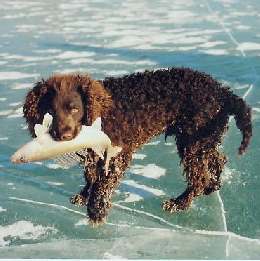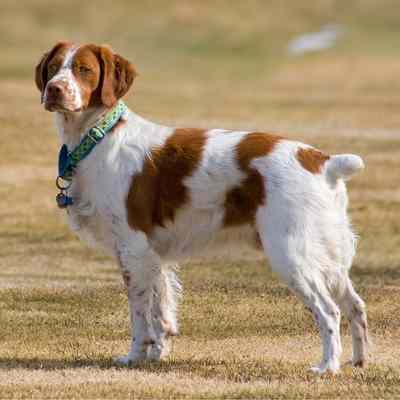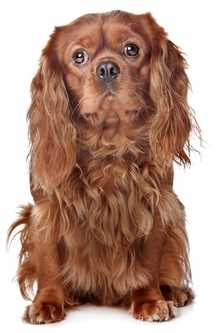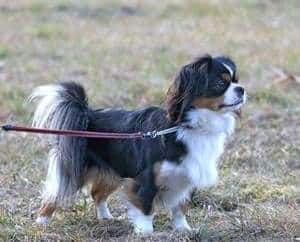Here are 21 Spaniel breeds that you may like!
There are probably more of types of Spaniel breeds than you may think. Perhaps 10 breeds? Or maybe 15? Or more? We list 21 breeds of Spaniel, most of them recognized by the American Kennel Club, plus a few that we feel deserve an extra mention. Of course, there are other Spaniels too, but not yet recognized by the AKC. And there one spaniel breed that is technically NOT a spaniel, it just picked up the name – Read on to find out which!
Spaniel Breeds – History
Historians believe that the Spaniel originated in Spain, hence “spaniel.” They have most likely has been around since the time of the Roman Empire. Clearly the breed was popular in Europe, given that descendants of it are around in force today.
The Spaniel didn’t remain limited to Spain for too long. The breed’s purpose in ancient times doesn’t have much debate around it either. The Spaniel saw widespread use as a versatile hunting dog. They were pros when it came to driving game out into the open, making these small game animals an easy target for their owners. This act of “springing” later led to the creation of the Springer Spaniel.
Alongside the Springer Spaniel, the Water Spaniel was another dog produced around this time. It was meant to assist hunters hunting waterfowl but saw less success than its springing cousins. The hunting experience of the Spaniel breeds is undoubtedly the reason for their prestige in the sporting class.
In the 17th and 18th century, Spaniels were simply divided into Water Spaniels and Land Spaniels. The Land Spaniel group was divided further into ‘Springing Spaniels’, ‘Field Spaniels’, and ‘Cocking Spaniels’. The advent of the Dog Show meant that it was important to identify what breed a spaniel belonged to.
By the 19th century, certain breeds became recognized for their size, shape, and the way they hunted. The Cocker Spaniel, for example, was used to flush Woodcock for the hunters. They were also smaller than the Springer spaniels, but bigger than the Toy spaniels.
While the Cocker and the Springer were still used for hunting and retrieving, for some reason the Field Spaniel became a favorite in the Show Ring, and they were bred for appearance and temperament rather than skill in the field.
This reduced their value as a gun dog, and over-breeding resulted in genetic health problems. The breed fell out of favor, and almost became extinct. However a small band of enthusiasts returned the Field to its roots, and by the 1960s we had a healthy Spaniel again.
All spaniel breeds have a working history, and as such still need plenty of exercise.
So, let’s look at the Spaniel breeds, by alphabetical order;
Spaniel Breeds – Spaniel Facts
(American) Cocker Spaniel

In the United States, the Cocker spaniel developed into 2 distinct breeds – American and English. Confusingly, they have slightly different names depending on which country you are in. In the USA the term ‘Cocker Spaniel’ refers to the breed called the ‘American Cocker Spaniel’ in England and Europe.
On the other hand, in Europe and the United Kingdom the term ‘Cocker Spaniel’ refers to the breed called the ‘English Cocker Spaniel’ in the USA. The American Cocker Spaniel is smaller than the English, with a shorter, domed head, a shorter nose, and it has longer ears and a longer coat. The link below takes you to our American counterpart, the American Cocker Spaniel page.
American Water Spaniel

As the name suggests, this is a Water Spaniel, and it originated in the Great Lakes area of the USA. They have a dense, waterproof coat, webbed feet and thickly padded feet. They have a deep chestnut – colored coat which is wavy or curly.
Developed by European migrants who settled in the region, they became all-round hunting dogs, with an excellent sense of smell, an ability to retrieve birds from water or land, and are extremely able swimmers. They can also spring game birds such as pheasant, quail and grouse.
Blue Picardy Spaniel

The Blue Picardy Spaniel (or Épagneul Bleu de Picardie) is a breed of Spaniel originating in France, from the area of the Somme River, at the beginning of the 20th century. This breed was developed from Picardy Spaniels and English Setters. This is a quiet breed of dog that requires a lot of exercise due to its stamina.
It is especially good with children. Similar to the Picardy Spaniel, it has a distinctive coloured coat. Recognised by only a handful of kennel associations, the breed is mainly known in France and Canada.
Brittany Spaniel

The Brittany is taller than most spaniels, with longer legs, often standing 20inches tall at the withers. They originate the the North Western region of France and are named after it, “Brittany”. They are versatile hunting dogs, capable of working with just about all game birds.
They are among the most popular and successful field dogs in America, and several have won the elusive dual champion title at the AKC, meaning that one dog has won both in the show ring and also in the field event.
Boykin Spaniel

The Boykin Spaniel originates in the South Carolina community of Boykin. According to the AKC, around 1900 a stray small brown Spaniel was adopted by a local resident, and taken hunting with his other dogs. It seem the little spaniel had a natural aptitude for flushing and retrieving.
The dog was then crossed with various other retriever and spaniel breeds, eventually resulting in the modern Boykin Spaniel. The dog excelled at hunting on the difficult, swampy terrain of the area.
Its popularity was limited to South Carolina for many years, but then the word spread, and the Boykin soon became popular with hunters all along the East Coast of the USA.
The Boykin Spaniel gained full AKC recognition in 2009. It has been adopted as the State Dog of South Carolina, and September 1st is Boykin Spaniel Day.
Cavalier King Charles Spaniel

The Cavalier King Charles is bigger than the standard King Charles Spaniel, weighing 13lbs to 18lbs as opposed to 8lbs-14lbs, but is still classed in the Toy Dog group by both the AKC and the Kennel Club (United Kingdom). The breed is a friendly and placid, and also good with children and other animals.
They are very sociable, and need human company. They do not tolerate being left alone for long periods at a time. The average lifespan of a Cavalier King Charles Spaniel is around 9 to 14 years.
Clumber Spaniel

Developed at the Duke of Newcastle’s northen England estate, Clumber Park, this breed is low-set and muscular, helping it to scramble through low brushwood and hedges when hunting.
The Clumber Spaniel is among the most low-keyed and easy going of the Sporting Dogs, although is still very much a hunter at heart. Indoors, he is quiet, calm, gentle and rather lazy. Preferring to curl up on a sofa, they enjoy snoozing and eating.
Continental Toy Spaniel (Papillon)
See below under Papillon
English Cocker Spaniel

English Cockers are larger than the American Cocker, with a flatter head, a longer nose, and shorter ears and coat. In the U.K., there are now 2 distinct versions of the breed. There is the Show Cocker, which looks a bit like the American Cocker Spaniel, and there is the Working Cocker.
The Working Cocker has a wider, flatter head, and a shorter coat. As the name implies, they are used as working dogs, and excel at flushing and retrieving. They are energetic and strong, and can work a long day in the field. At home they are loving and affectionate, and bond very closely with their owners. They are among the most popular British spaniel breeds.
English Springer Spaniel

The English Springer Spaniel is an affectionate, sociable companion that can also serve as a working dog. The breed is well known for being smart.
These dogs are also known for their playfulness, making for a great family pet. Guests love these dogs for the warm welcome they get when visiting their home.
They are the right size to be able to play with children without a high risk of injuring them. Their energy and playfulness are especially appreciated amongst kids, but they should always be monitored when playing with small children.
English Toy Spaniel (King Charles Spaniel)

The English Toy Spaniel (King Charles Spaniel) is smaller than the Cavalier King Charles, weighing just 8lbs to 14lbs, s opposed to the 13lbs – 18lbs or more of the Cavalier.
The Toy Spaniels that would eventually become the English Toy Spaniel had their roots in Asia rather than Europe. Most originated in Japan and were given as gifts to European royalty by the Japanese. It didn’t take long for the breed to become very popular in Europe, as there was a particular fad surrounding toy breeds during the 1500s. They saw special admiration among the British aristocrats and royalty.
These were basically Toy sized versions of favorite sporting spaniels. During the reign of Queen Victoria, these toy spaniels were crossed with Pugs and Japanese Chin dogs to give the breed a smaller nose and flatter face.
This breed then became known in America as the English Toy Spaniel, and the King Charles Spaniel in the U.K.. This new-style toy spaniel dominated for many years, until breeders undertook to reproduce the original look of the toy spaniels from King Charles’ time, eventually creating the CAVALIER King Charles in 1920s.
Field Spaniel

Closely related to Cockers and Springers, the Field Spaniel is less common and generally less well-known. This may be the most docile and amiable of the Spaniel breeds, and make tranquil house dogs.
However, they are still Spaniels at heart, and love getting outdoors for a good run. They are tolerant and trustworthy with children and other animals. They have a big appetite, and will eat just about anything that’s edible.
French Spaniel

The French Spaniel is also called the Epagneul Français in French. This is one of the larger breeds of Spaniel. It has a white coat with brown markings. Like all spaniels, this is a friendly breed that has few health issues.
The breed is recognised by Canadian and international kennel clubs but not by The Kennel Club (UK). The American Kennel Club has included the breed in its Foundation Stock Service, the first step to full recognition.
German Spaniel (Wachtelhund – German Quail Dog)

This is a versatile spaniel breed, but pretty much unknown to the German public. They are normally only owned by professional hunters and gamekeepers in Germany. They first appeared around 1890, and were bred for hunting, scenting and flushing, originally quail.
The German Spaniel is a medium-sized, longhaired, very muscular gun dog. Their innate love of water means they are also often used to hunt waterfowl.
Irish Water Spaniel

The Irish Water Spaniel is one of the tallest of the Spaniel breeds, standing at 22 inches to 24 inches at the withers. They have a tightly curled waterproof coat, and may be mistaken by some for a Poodle.
Before the 1850s in Ireland, there were 2 types of Water Spaniel – the North Country and the South Country. The breeds were crossed, and by 1859 the Irish Water Spaniel had come into being. The breed proved very popular for it’s abilities and gentle nature, and in the 1870s several dogs were exported to the USA.
The Irish Water Spaniel was one of the first breeds to be registered at the AKC in 1878, and was officially recognized when the AKC was properly founded in 1884.
Papillon (Continental Toy Spaniel)

Originally bred to be companions and lapdogs for noblewomen in Europe, the Papillon was developed by crossing existing toy dogs with Spaniels.
The Papillon is a small breed that is well known for its known for its affectionate and energetic personality. These dogs are always looking for something to do, so they make for playful company. They are very social and are excited when they get to meet new faces. This energetic dog makes for a lively and fun pet.
Phalene

According to the American Kennel Club, the Phalene is a Papillon, but with different ears. It is referred to as a “Phalene Type” of Papillon. We list it separately here because the FCI regard them as separate breeds, however the links here go to our Papillon page.
Russian Spaniel

First appearing after the Second World War, the Russian Spaniel is the only gun dog to originate in Russia. The breeding program included English Cocker Spaniels and Springer Spaniels, and the resulting dog was used for hunting game birds.
They have become very popular in Russia, but only appeared overseas after 1990. The breed is not recognised by any Western kennel clubs, only by Russian Kynological Federation.
Sussex Spaniel

Although not particularly tall, at 15 inches, the Sussex Spaniel is deep-chested and heavy boned. This is a solid dog! The history of the Sussex Spaniel begins in Sussex, England. They were bred to be low-profile but powerful, so they could plow through the heavy clay soils of the area while pursuing all manner of game birds.
As they were quite low to the ground, making their way through shrubs, brushwood and tall grass, they were not visible to the hunters, and so dogs that made sounds were preferred. To this day, the Sussex is a relatively loud dog, barking, whimpering and howling quite frequently. They make excellent watchdogs!
Tibetan Spaniel

This breed originated in monasteries in Tibet over 2000 years ago; They were bred to be watch dogs. They are not true spaniels, as they were never used in hunting, but they picked up the name most likely because of their physical resemblance to spaniels. They are very intelligent, and need human company.
Welsh Springer Spaniel

In size, the Welsh Springer Spaniel is bigger than the American Cocker, but not as big as the English Springer. According to the AKC, this is Britain’s oldest Spaniel breed, but how they got from mainland Spain to Wales is lost in time.
Working Cocker Spaniel

The English Working Cocker Spaniel is an English Cocker Spaniel that has maintained its breeding as a working and hunting dog, as opposed to the Cocker Spaniels that were bred for the show ring. The latter are the most popular as domestic pets, but the Working Cocker has its own attractions!
We hope you enjoyed our page on Spaniel Breeds and Spaniel Facts. The information is based on American Kennel Club entries and National Breed Association sources.



